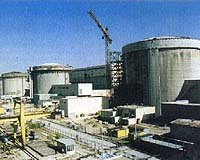 |
Angra Dos Reis, Brazil (AFP) April 27, 2011 Brazil's Angra dos Reis bay is a tropical paradise that attracts droves of tourists each year. But it is also sharply in focus as the home of the nation's only nuclear power plant. Brazilian officials insist things are safe at the two pressurized water reactors, Angra I and Angra II, which face the sea some 150 kilometers (90 miles) west of Rio de Janeiro. But security improvements have been stepped up in the wake of the devastating disaster at Japan's Fukushima nuclear power plant, crippled by a March 11 earthquake and tsunami. "We were taking measures (to improve security), but Fukushima accelerated them," Jose Manuel Diaz Francisco, in charge of security at Electronuclear, the public company in charge of the plants, told AFP. Angra I, which has been in operation since 1985, has an output of 657 MWe, while Angra II, in operation since 2001, has an output of 1,350 MWe. While there is little chance of an earthquake on the Brazilian coastline, the reactors are surrounded by hills prone to landslides: in 1985 a catastrophe was narrowly averted when a mudslide nearly blocked the plant's cooling water discharge area. Both reactors last year provided 32 percent of the electricity in the state of Rio de Janeiro, Brazil's third most populous state -- which amounts to less than five percent of the country's electricity demands. Currently 85 percent of electricity in Brazil is generated by hydroelectric power plants. However, experts say by 2020 the country's numerous rivers will not be able to meet the output needed as the Brazilian economy booms and demand for energy continues to grow. After 24 years of controversy, work on the construction of a third reactor, Angra III, resumed in June 2010, with an expected completion date of 2015. The plant is expected to generate 1,400 MWe. Brazil has plans to build up to eight nuclear power plants by 2030, even though nuclear energy is extremely unpopular: 54 percent of Brazilians oppose nuclear energy, while 57 percent fear a nuclear accident, according to a recent poll by the IBOPE institute. An Electronuclear spokesperson said the Angra reactors are safer than the damaged Japanese reactors because they use pressurized water in the process and not boiling water. Nevertheless Electronuclear engineers have studied the Japanese experience and plan to build a small hydroelectric plant near the ocean to provide backup power to cool the reactors in case of a catastrophic power failure. Authorities also plan to build jetties to evacuate the 20,000 people living near the power plants in case landslides block the sole coastal road. Greenpeace activists believe those safety measures don't go far enough, and vehemently oppose construction of the third reactor. On Monday, some 20 activists dressed in orange overalls and wearing gas masks hurled smoke bombs outside the Bank of Public Development (BNDES) in Rio de Janeiro. The bank is to provide more than 60 percent of the financing for the plant, estimated to cost some 5.8 billion dollars. "We are calling for the immediate halt of this loan," said Ricardo Baitelo with the local Greenpeace chapter. "Brazil has the means to replace nuclear with safer renewable energy sources," such as wind and solar power, Baitelo told AFP. For Baitelo, now is the time for the government to revisit plans to build more nuclear power plants. Argentina is the only other South American nation with nuclear power plants.
Share This Article With Planet Earth
Related Links Nuclear Power News - Nuclear Science, Nuclear Technology Powering The World in the 21st Century at Energy-Daily.com
 Romania seeks private money to build nuclear plant
Romania seeks private money to build nuclear plantBucharest (AFP) April 27, 2011 Romania wants to attract private investors to modernise its road infrastructure and to build two new reactors at the Cernavoda nuclear plant, Prime Minister Emil Boc said Wednesday. "The government wants to resort to public-private partnerships in order to launch infrastructure works not benefitting from public money or European funds," Boc told a press conference. He said the list inclu ... read more |
|
| The content herein, unless otherwise known to be public domain, are Copyright 1995-2010 - SpaceDaily. AFP and UPI Wire Stories are copyright Agence France-Presse and United Press International. ESA Portal Reports are copyright European Space Agency. All NASA sourced material is public domain. Additional copyrights may apply in whole or part to other bona fide parties. Advertising does not imply endorsement,agreement or approval of any opinions, statements or information provided by SpaceDaily on any Web page published or hosted by SpaceDaily. Privacy Statement |